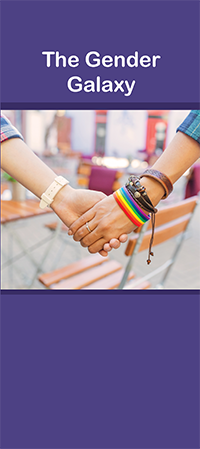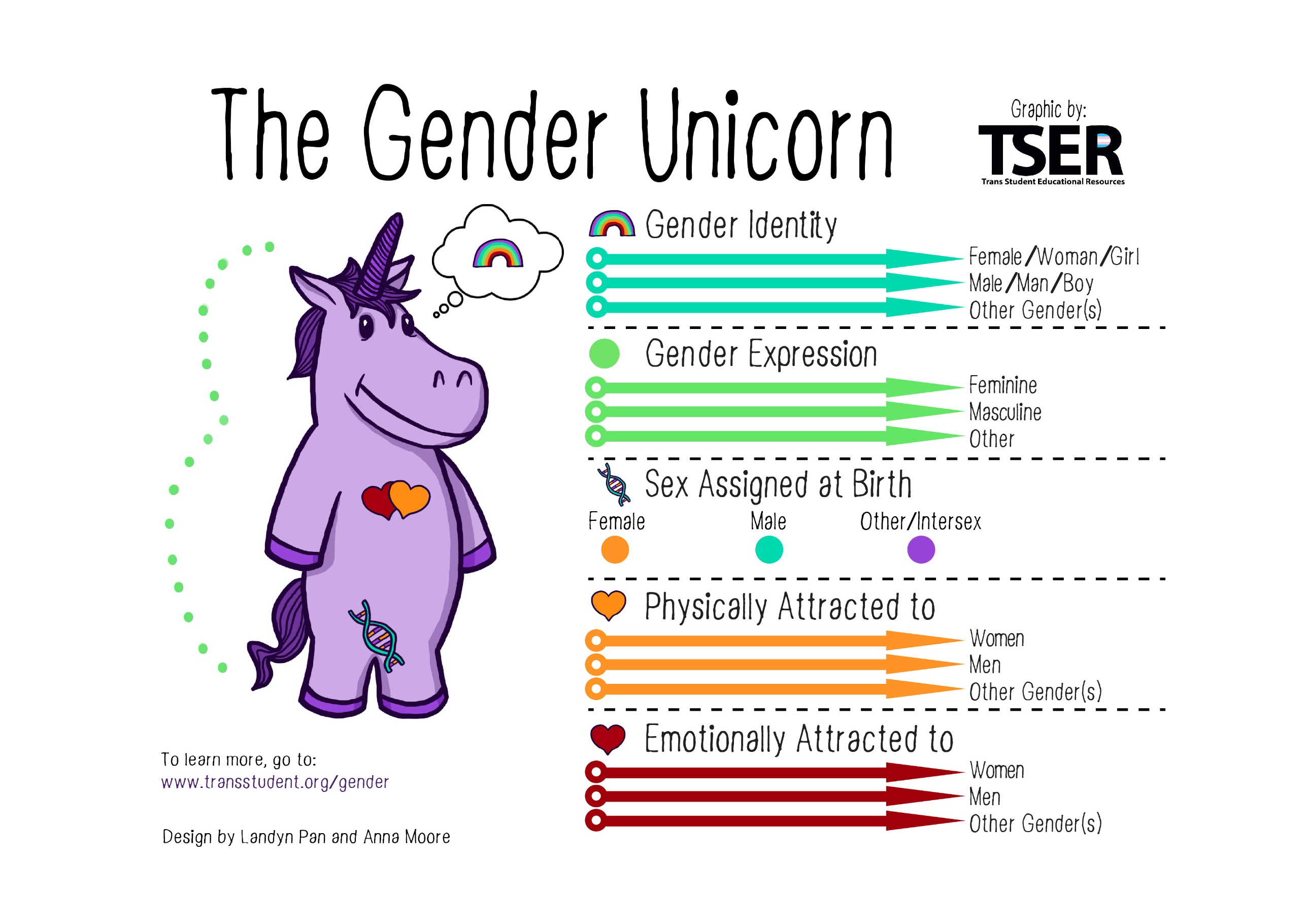Brochures are sold in packages of 25.
When was the first time you remember being aware of gender?
What is your earliest memory of your gender identity? What helped you become aware of your gender?
What assumptions do people make based on your gender? What assumptions about gender do you make
about others? How are you impacted by gender norms and stereotypes?
Gender is complex and fluid as you can see in the questions listed above. For some, these questions
may be simple to answer while for others the answers are more complex. This is all a natural part
of exploring gender identity, and the purpose of this brochure is to provide a vocabulary and
understanding for those who may be curious about their own identity and how they relate to others.
Dimensions of Gender
Below are some terms that are useful to understanding the wide range of identities and expressions.
Gender Identity: An individual’s sense of self, such as: non-binary, man, woman, transgender, cisgender, gender expansive, and more gender categories. Gender identity represents how an individual experiences themselves at an intrinsic level.
Gender Expression or Gender Presentation: How an individual chooses to express or represent their gender. Individuals may express their gender through clothing, hairstyle, behaviors, voice or body characteristics, or other forms of presentation.
Sex Assigned at Birth: A medical term designating a certain combination of chromosomes, gonads, external organs, secondary sex characteristics, and hormonal balances to classify an individual as female, male, intersex, or another sex assigned at birth.
Gender Perception: How other people perceive a person’s gender expression. How people perceive an individual’s gender may not be congruent with that individual’s gender identity. For example, a person may be misgendered when others’ perceptions of their sex characteristics or gender expression do not match the person’s gender identity.
Gender Identity versus Sexual Orientation
There is an important distinction between gender identity and sexual orientation. Sexual orientation often refers to the relationship between one’s gender and that of the people they are attracted to emotionally, romantically, and/or sexually. Examples of sexual orientation identities include, but are not limited to, gay, lesbian, queer, bisexual, asexual, and heterosexual. Though it is often perceived that gender identity and sexual orientation are connected, the reality is that each are entirely different dimensions of identity. One does not determine the other.
The Gender Binary: An Incomplete View
Historically, many cultures have defined gender in a binary fashion. There is an assumption that every person can be labeled as either a woman or a man. The gender identity of an individual has often been determined by a combination of the sex an individual is assigned at birth and their gender expression. Many people assume that if someone’s sex assigned at birth is female, then they will dress and behave in feminine ways and identify as a woman. Similarly, for a person assigned male at birth, we assume they will wear masculine clothes and identify as a man. However, because sex assigned at birth and gender identity are two separate concepts, gender is much more diverse than what we just described.
The Gender Unicorn: A More Inclusive Model
Developed by Trans Student Educational Resources, the gender unicorn demonstrates that gender identity, gender expression, sex assigned at birth, and forms of attraction are separate categories that may or may not influence one another. This model shows that each category is on a spectrum that starts at one points and goes on infinitely. If we were to allow for a more complex way of thinking about gender as illustrated in the graphic below, we may recognize what can be called a “gender galaxy.” In the gender galaxy, there are an infinite number of gender points in the galaxy and these points are not fixed. They are fluid and can move a little or a lot. In addition, imagine that all of these points were equally supported and accepted by society. This way of thinking about gender can be a difficult shift given that in most societies, we are taught that the
gender binary is concrete and unchanging. Add the complexities of ethnicity, social class, culture, religion, and other identities, and the galaxy expands even further.
A Word about Language
Language has the power to shape opinions and behaviors. Language can often lock into place a way of
thinking about the world. If there are not accurate words to describe something complicated, we
tend to oversimplify it. This is the case with gender. Here are some definitions that may be
helpful in expanding your understanding of the gender galaxy. Instead of using these terms to label
someone, allow people to identify their gender for themselves. As you read, please keep
in mind that language is ever evolving and this list of terms is not comprehensive. We encourage
you to use additional resources to explore words that you may not be familiar with.
Transgender/Trans: An umbrella term that is used to describe a diverse group of people who do not
identify or do not exclusively identify with their assigned sex at birth. Trans may refer to people
who identify as transgender, genderqueer, genderfluid, beyond the binary, genderless, agender,
third gender, two-spirit, bigender, and more.
Gender Expansive: People who have a broad and flexible range of gender expression and are not
limited to a single stereotypical binary gender narrative or experience.
Intersex: A term that includes a variety of people who are born with chromosomal, hormonal,
anatomical, and/or secondary sex
characteristics that do not seem to fit the typical definitions of female or male. Intersex is a
socially constructed category that reflects real biological variation.
Cisgender/Cis: People who exclusively identify with their assigned sex at birth. For example, someone who was assigned female at birth and also identifies their gender as female.
Transphobia: Fear and/or hatred of individuals who transgress, violate or blur the dominant gender categories in a given society. Such attitudes lead to discrimination, violence and oppression against the Trans community.
Cisgenderism: The assumption that gender is based on assigned sex at birth.
Cissexism: A form of prejudice in the favor of cisgender people. The beliefs and attitudes that cisgender identities are better or more valid than transgender identities.
Pronouns
Many languages assign different pronouns to men/male and women/female referents. Gendered pronouns may not fit with a person’s gender identity, and people may use gender inclusive pronouns. Do not make
assumptions about the pronouns that people use—politely ask them, “What pronouns do you use?”
Becoming More Aware of the Gender Galaxy
- As you become more aware of the gender galaxy, here are some things you can do to increase your understanding:
- Be aware of your own attitudes about gender diversity. How did these attitudes develop? How have you treated people who are different from you in how they express their gender?
- Try to go through one day without using any gendered pronouns.
- This may help you to develop a better idea of the pervasiveness of gendered language.
- Avoid making assumptions about sexual orientation based on gender identity and vice versa.
- Become familiar with local, regional and federal laws (or lack thereof) protecting gender expansive individuals from discrimination.
- Attend a training on how to be an ally for gender diversity.
- Review the International Bill of Gender Rights, which is listed below. Note which rights you have been taking for granted or have been denied.
- Become aware of microaggressions, which are commonplace daily verbal, behavioral, or environmental indignities, whether intentional or unintentional, that communicate hostile, derogatory, or negative slights and insults toward members of oppressed groups.
International Bill of Gender Rights
1. The right to define gender identity.
2. The right to free expression of gender identity.
3. The right to secure and retain employment and to receive just compensation.
4. The right of access to gendered space and participation in gendered activity.
5. The right to control and change one’s own body.
6. The right to competent medical and professional care.
7. The right to freedom from involuntary psychiatric diagnosis and treatment.
8. The right to sexual expression.
9. The right to form committed, loving relationships and enter into marital contracts.
10. The right to conceive, bear, or adopt children; the right to nurture and have custody of children and to exercise parental capacity.
Get Help ASAP
The National Suicide Prevention Lifeline is available 24/7 at 1-800-273-TALK (8255). They also offer a chat option through their website, suicidepreventionhotline.org/chat/.
Want to Know More?
Bornstein, K. & Bergman, S. B. (2010) Gender outlaws: The next generation. Berkeley: Seal Press.
Brill, S. & Pepper, R. (2008) The transgender child: A handbook for families and professionals. San Francisco: Cleis Press.
Intersex Society of North America (2008). What is intersex? Retrieved from: isna.org/faq/what_is_intersex
Frye, P. R. (2000). The International Bill of Gender Rights vs. The Cider House Rules. William & Mary Journal of Women and the Law, 7(1), 133-216.
Nadal, K. L. (2013). That’s so Gay! Microaggressions and the lesbian, gay, bisexual, and transgender community. Washington, DC: American Psychological Association.
Pan, L., Moore, A. (2019). The Gender Unicorn. Trans Student Educational Resources. Retrieved from transstudent.org/gender
Roughgarden, J. (2004) Evolution’s rainbow: Diversity, gender, and sexuality in nature and people. Berkeley: University of California Press.
Trans Student Educational Resources. Retrieved from transstudent.org

